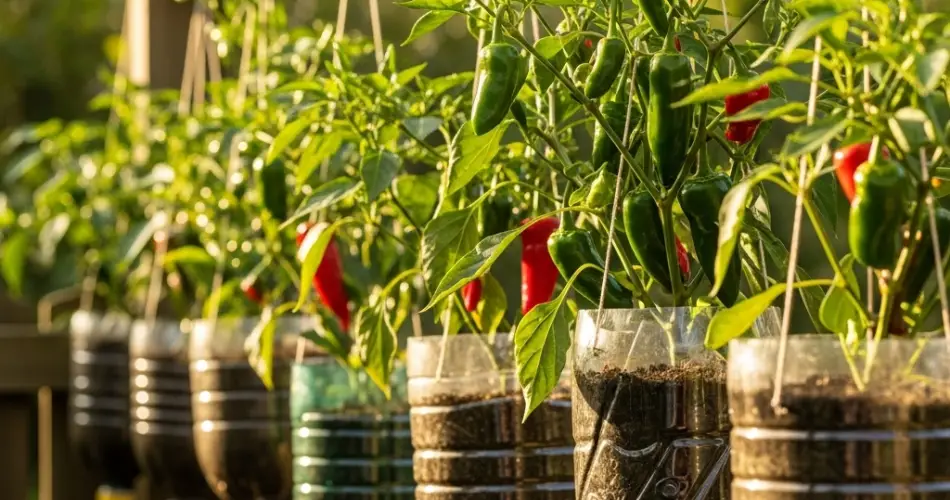Pepper plants are a colorful and flavorful addition to any home garden. Whether you’re growing sweet bell peppers or spicy chilies, these plants are remarkably adaptable—and one innovative method of cultivation is using hanging plastic bottles. This vertical gardening technique is perfect for those with limited space and is a great way to recycle used plastic containers while producing fresh peppers right on your wall, balcony, or patio.
With the right setup, sunlight, and care, hanging bottle gardens can yield an abundant pepper harvest without the need for garden beds or large containers. This guide will walk you through how to successfully grow pepper plants in hanging bottles from start to harvest.
Why Use Hanging Bottles for Peppers?
Growing peppers in hanging plastic bottles is not just a space-saving solution—it also has practical gardening benefits:
-
Efficient use of space: Ideal for balconies, walls, fences, or small patios.
-
Recycling plastic: Helps reduce waste by repurposing used bottles.
-
Better drainage: Prevents root rot by allowing excess water to drain easily.
-
Improved air circulation: Keeps plants healthy and reduces disease risk.
-
Easier maintenance: Plants are off the ground, making watering, pruning, and harvesting more convenient.
This method works especially well for compact pepper varieties that don’t require large root systems.
Best Pepper Varieties for Bottle Growing
While most peppers can adapt to container life, some varieties are especially well-suited for growing in limited spaces like plastic bottles:
-
Cayenne – Slim, spicy peppers that grow well in compact containers.
-
Jalapeño – A sturdy, medium-sized chili perfect for vertical gardens.
-
Mini Bell Peppers – Sweet and colorful with smaller fruit ideal for small containers.
-
Thai Chili – Productive and compact, perfect for hanging setups.
-
Banana Peppers – Mild and versatile, these grow well in bottle planters.
Choose pepper types based on your climate, taste preference, and the available sunlight in your space.
Materials You’ll Need
To create your hanging bottle garden for peppers, you’ll need:
-
1.5–2-liter plastic bottles
-
Sharp scissors or a utility knife
-
Quality potting soil
-
Compost or organic fertilizer
-
Pepper seedlings or seeds
-
Strong string, wire, or rope
-
A drill or heated metal tool for making holes
Ensure your bottles are clean and strong enough to hold soil and moisture for several weeks.
Preparing the Bottles
-
Clean thoroughly: Wash and remove all labels from the bottles.
-
Cut an opening: Lay the bottle horizontally and cut a rectangular slit on one side about 4–5 inches wide for planting.
-
Drainage holes: Make several small holes in the bottom of the bottle to allow excess water to escape.
-
Hanging holes: Puncture two holes near the top edge (on either side of the cut opening) to insert rope or wire for hanging.
You can hang the bottles along a fence, on a wooden board, or from wall hooks in a sunny location.
Soil and Fertilizer
Peppers grow best in fertile, well-draining soil. To prepare the growing mix:
Ideal mix:
-
2 parts quality potting mix
-
1 part compost or aged manure
-
Optional: A small amount of sand or perlite to improve drainage
Mix in a slow-release vegetable fertilizer before planting, and supplement with a liquid feed every two weeks during flowering and fruiting.
Planting the Peppers
-
Fill each bottle with the prepared soil mix, leaving about an inch of space at the top.
-
Transplant seedlings into the planting slit. If using seeds, sow 2–3 per bottle and thin out the weakest ones after sprouting.
-
Firm the soil gently around the roots and water thoroughly.
Most bottles are best suited for one pepper plant each to give enough space for root development and airflow.
Sunlight and Watering
-
Sunlight: Pepper plants need at least 6–8 hours of direct sun each day. South- or west-facing walls are ideal for hanging setups.
-
Watering: Keep the soil evenly moist, not soggy. Hanging bottles tend to dry out faster, especially in warmer climates, so check daily and water as needed.
-
Mulching: Use a layer of mulch inside the bottle (such as straw or dried leaves) to help retain moisture.
Avoid letting the soil dry out completely, as this can cause flowers or young fruit to drop.
Care and Maintenance
-
Support: As peppers grow, they may become top-heavy. Secure the plant with small stakes or tie gently to a support if needed.
-
Pruning: Remove yellowing leaves and pinch off early flowers if you want to encourage more leafy growth first.
-
Pests: Keep an eye out for aphids, whiteflies, or spider mites. Treat with neem oil or insecticidal soap if necessary.
Proper airflow, good drainage, and regular inspection will help prevent common pepper plant issues.
Harvesting Your Peppers
Depending on the variety, peppers are ready to harvest between 60–90 days after planting. You can harvest them while green or wait for them to ripen to their mature color—red, yellow, orange, or purple.
To harvest:
-
Use scissors or garden snips to cut the pepper from the stem.
-
Avoid pulling, as this can damage the plant or unearth its roots in the bottle.
Frequent harvesting encourages more fruit production and helps the plant stay productive.
Final Thoughts
Growing peppers in hanging plastic bottles is a simple, sustainable, and highly productive method—perfect for small spaces and eco-conscious gardeners. With just a few recycled materials and a sunny wall, you can enjoy a colorful harvest of fresh peppers all season long. Whether you’re into spicy chilies or sweet bells, this vertical gardening method is a practical way to grow your own food right at home.



